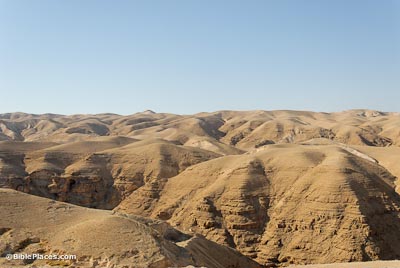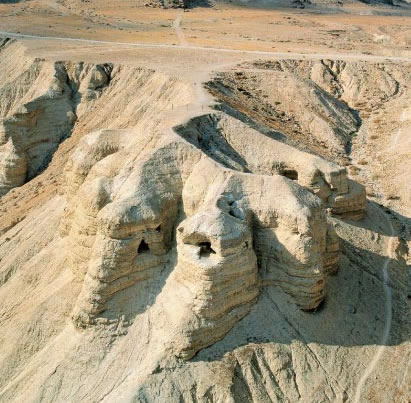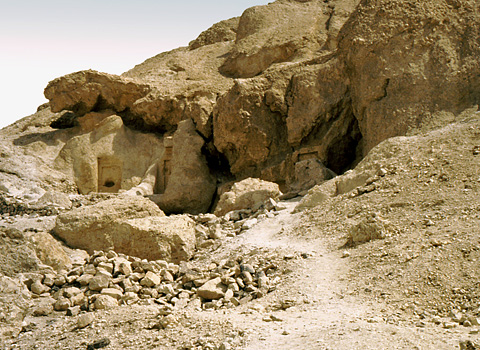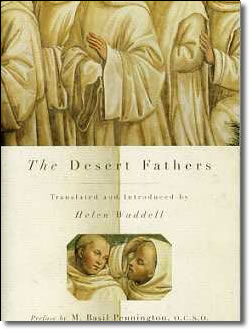CH101 - The Fourth Century
The Development of the Monastic MovementOutline
Diocletian and Church Growth
The "Great" Persecution under Diocletian
Constantine becomes the Emperor
Initial Heresies (Donatus - Arius)
The Faith of Constantine
The Council of Nicea, 325AD
The Nicean Creed
Post-Nicean History
Christianity - Post Nicea
These pages are coming soon:
- Fourth Century Orthodoxy
- Death of Constantine
- Julian the Apostate
- Jovian-Valentinian and Valens
- Christianity becomes the Official Religion
Christianity has been heavily influenced by the monastic movement. Just a quick listing a few names illustrates this point: Augustine of Hippo, Jerome, Benedict, Basil the Great, Boniface, Patrick of Ireland, Thomas Aquinas, Ignatius of Loyola, Martin Luther, Erasmus, John of the Cross, and Mother Teresa - there are many more.
Among the positive contributions of the monastic movement would be the push of missions to new frontiers, the copying of New Testament manuscripts, social missions like the building of orphanages, hospitals, and a significant influence in the starting of universities, caring for the sick and dying in the Black Plague of Europe, and the continuation of what is known as contemplative prayer - and there are more.
Monasticism is typically known for the practice of disciplines: prayer, fasting, celibacy, and vows of poverty. While these disciplines are found in varying degrees around the world in all Christian traditions, the different monastic orders are probably most responsible for keeping these traditions alive. These traditions are known as forms of asceticism (from the Greek: askesis, "training" like one would engage in to be an athlete) and are found in the New Testament (in varying degrees).
Asceticism Moses to the New Testament
 We see some examples of askesis in the Old Testament: fasting, the Nazarite vow, and living in tents to celebrate the Feast of Tabernacles. Moses ascends the mountain to "meet with God:"
We see some examples of askesis in the Old Testament: fasting, the Nazarite vow, and living in tents to celebrate the Feast of Tabernacles. Moses ascends the mountain to "meet with God:"
This text regarding Moses is huge - Moses becomes the archetype in the monastic tradition for the spiritual man. In addition to Moses being the "author" of the Law, it is recorded that Jesus follows the example of Moses:
he was hungry. Matt 4:1-2
This text introduces another motif, or symbol, that becomes a vital part of the monastic movement - the wilderness. Paul seems to echo this theme immediately after his encounter with the risen Jesus:
I went up to Jerusalem. - Gal 1:17-18
This has been seen by many as Paul's journey into the wilderness to get his head straight (after the examples of Moses, Elijah and Jesus). Paul (at least in Acts) affirms fasting, certainly affirms some kind of prayer discipline, and also gives at least a simple affirmation of celibacy.
Jewish Monasticism
Many Christians do not fully understand the roots of monasticism that can be found in first few centuries BC through the time of Christ. Because this is "101" we cannot spend too much time here, but we do want to mention these roots:
1. Philo of Alexandria and The Contemplative Life
Philo was a contemporary of Jesus and Paul, living in Alexandria, Egypt. During the first century AD Alexandria had the largest population of Jews outside Jerusalem and the boundaries of Israel - it is estimated that 1.5 million Jews lived in and around the outskirts of the great Egyptian city. The world famous ancient library and one of the leading philosophical schools was located in Alexandria, and Philo was connected with both as a spiritual Jew, philosopher and somewhat involved in Roman politics.
One of his many treatises is The Contemplative Life, a description of The Therapeutai, a community of Jews living in something like a monastic community in the desert of Egypt. The description Philo gives of this group sounds something like a 20th century charismatic worship service (edited to be concise):
2. The Qumran Society
 When the Dead Sea Scrolls were discovered scholars learned of the Essenes, another Jewish monastic group living very similarly to Philo's Therapeutai. This group lived in community, also in the desert environment near the Dead Sea, spending the bulk of their lives in prayer, fastings, reading the OT scriptures and waiting for the arrival of OT Elijah who would usher in the judgement of God to overthrow the Romans and the corrupt Jewish Temple system.
When the Dead Sea Scrolls were discovered scholars learned of the Essenes, another Jewish monastic group living very similarly to Philo's Therapeutai. This group lived in community, also in the desert environment near the Dead Sea, spending the bulk of their lives in prayer, fastings, reading the OT scriptures and waiting for the arrival of OT Elijah who would usher in the judgement of God to overthrow the Romans and the corrupt Jewish Temple system.
Many scholars believe that John the Baptist lived with this group prior to his open ministry described in the gospels. This theory comes from John living in the desert, the similarity of his message with the Essenes (the coming of Elijah and God's judgement) and his call for water baptism. The Qumran community practiced baptism for soul and spiritual cleansing.
One last connection between the Qumran community and the early Christian movement is seen in two early writings: The Epistle of Barnabas and Didache. Both of these documents include what is now called "The Two Ways," a text that reminds the reader of blessings and cursings given to Israel in the advent of the Law. Here is a short excerpt of the "Two Ways" from the first two chapters of Didache:
The significance of the "Two Ways" teaching is that it can also be found in the Qumran texts, thus another connection between Jewish monasticism and early Christianity.
Spiritual Disciplines and Dualism
 Spiritual disciplines tend to flow from a fundamental belief of a spiritual battle between good and evil, the kingdom of light and that of darkness. This physical world is evil and the spiritual world is aligned with God. Thus for the person seeking spiritual union with God, to be a "soldier" in His army, there is a need to distance the self from the physical world of pleasure. Typically, this is seen as "worldly" pleasures: sexual sin, gluttony, greed, etc. This view of reality is sometimes referred to as dualism and can be found sprinkled throughout the teachings of Jesus and Paul.
Spiritual disciplines tend to flow from a fundamental belief of a spiritual battle between good and evil, the kingdom of light and that of darkness. This physical world is evil and the spiritual world is aligned with God. Thus for the person seeking spiritual union with God, to be a "soldier" in His army, there is a need to distance the self from the physical world of pleasure. Typically, this is seen as "worldly" pleasures: sexual sin, gluttony, greed, etc. This view of reality is sometimes referred to as dualism and can be found sprinkled throughout the teachings of Jesus and Paul.
I have been correctly challenged by a reader in my use of the term dualism and I need to give some explanation. Proper dualism is a system that sees two equal and opposing spiritual forces, both primal or uncreated, like the Chinese yin and yang. In the mid-second century Marcion introduced a form of dualism that was rejected. He held that the god of the Old Testament was NOT the same as the God of Jesus in the New Testament. He dismissed the Old Testament and rejected anything that reminded him of this system. The Church rejected his system of thought.
I am NOT a trained theologian. I agree with the correction of my reader - Christianity does NOT hold to dualism. Yet, I have been accused by trained theologians of presenting a form of dualism because of my view of a real "kingdom of darkness." THIS is clearly represented in the teachings of both Jesus and Paul.
This view is reflected in the monastic tradition and is the foundation for the development of spiritual disciplines.
Unfortunately this view of the universe is not easy to manage. It has not been uncommon for those who practice spiritual disciplines to take the concept further than what has just been described. In the second century we find forms of ascetic Christianity mixed with extreme dualism. Some forms of Gnosticism believed that ALL pleasure should be avoided and some Christian ascetics seemed to do this as well.
Clement of Alexandria's Paidagogus (cir. 195-210 AD) lays out what and how the spiritual Christian will live: a disciplined life in how one eats, walks and speaks. Origen of Alexandria's writings (cir. 220-250 AD) further develop a disciplined approach to prayer and other spiritual disciplines. Origen lived a life of spiritual disciplines. His example of celibacy, though drastic, was seen as virtuous.
Anthony of Alexandria (Also St Anthony or Anthony the Great)
![]() Between 356-362 AD a document called the Life of Anthony begins to be circulated. This document is said to have been written by Athanasius, the great bishop of Alexandria as a tribute to Anthony just after his death. According to this writing Anthony was the son of wealthy Christian parents and inherited this wealth in his teens after the death of both parents. Around the year 270AD on a Sunday morning the preacher read from the story of the Rich Young Ruler: "Go, sell all of your possessions, give the money to the poor, then come follow me."
Between 356-362 AD a document called the Life of Anthony begins to be circulated. This document is said to have been written by Athanasius, the great bishop of Alexandria as a tribute to Anthony just after his death. According to this writing Anthony was the son of wealthy Christian parents and inherited this wealth in his teens after the death of both parents. Around the year 270AD on a Sunday morning the preacher read from the story of the Rich Young Ruler: "Go, sell all of your possessions, give the money to the poor, then come follow me."
Apparently the Holy Spirit gripped Anthony's heart. He follows this command and sets out to live a life totally given to following Christ. There were men at this time living as hermits, attempting to give themselves completely to following Christ. Anthony ventured to the edge of his village and began to give himself to prayer, fasting and working with his hands. This is the beginning of what turns out to be 10-20 years of living in solitude in the Egyptian desert.
Over the years Anthony becomes known as a mighty man of God. People carried the sick to be prayed for by Anthony, according to the Life many are healed. Rulers sought him out for spiritual guidance and counsel. Over the years the legend of his life grew and many young men ventured out into the desert where he dwelt, seeking to follow his example and living in caves near Anthony.
Athanasius comes to know Anthony and writes the Life of Anthony as a tribute to the great man. Some also believe that Athanasius used Anthony and the Life to promote his theological struggle against the Arians. The Life of Anthony spreads like a virus. Literally hundreds, then thousands of mainly young men (and some women) strike out into the desert to follow the new martyrs - those who willingly live in desert caves, eating very little (mainly steamed cabbage and bread, not much of either), giving themselves day and night to prayer, fasting and reading the biblical texts and other sacred writings (Clement and Origen were said to be found in some of these caves). By the later 320's it was said that over 5,000 monks lived in the caves of the Nile Delta in a loose, yet connected community. By 390 AD there were over 50,000 monks living this monastic lifestyle, though by this time many formal monasteries had developed.
The Desert Fathers
 Even after monasteries began to be formed many men would continue to live in the loosely formed communities and the cave dwelling lifestyle of the early monks. Several documents developed known as Sayings of the Desert Fathers. These documents help historians to know the details of this period and of these men.
Even after monasteries began to be formed many men would continue to live in the loosely formed communities and the cave dwelling lifestyle of the early monks. Several documents developed known as Sayings of the Desert Fathers. These documents help historians to know the details of this period and of these men.
The following notes come from my paper [You can read the paper with footnotes "An Introduction to the Desert Fathers" based on the Helen Waddell text.]
The Sayings of the Desert Fathers give us a glimpse into the asceticism, the
practical theology, and the heart of what the monastic life was all about, at least in
these early years. These Sayings were passed down orally among the monks until such a time as it was thought necessary to write them down. Much has been written to
show the excesses of the monastic tradition - the overzealous use of discipline, self denial, and obedience to the common rule, competition (which community or
individual had the most rugged practice), and dualism (that our flesh is evil).
The Sayings is a collection of pithy statements and short stories which capture the heart and soul of the monastic life in the communities of the Egyptian and Palestinian deserts. The focus is to illustrate both the lives and the teachings of the teachers (referred to as abbot, old man, or pastor). There are short Books (chapters) which focus on various aspects of discipline; "Quiet and Solitude," "Self-restraint,"
"Fornication," one against material possessions, one on patience, humility,
discretion, and other topics. The stories illustrate the virtues of different brothers
and the lack thereof. Some of the stories show great insight, others are obtuse and
hard to figure out. Some of the stories make the desert life seem very real, others
are so legendary and ridiculous that one wonders why they were passed down at all.
But that is really the point – these sayings are filled with enigma. It is very difficult
to make generalizations; one story might affirm some abject discipline while the
next shows the lack of virtue in the misapplication of the very same discipline. Like
the scriptures, Sayings is a very honest presentation of these interesting men,
showing us the positives as well as the negatives.
[A note concerning women. The earliest "communities" we find in church history
are those for virgins and widows. This was a highly esteemed group in the early
church – they cared for the needy and were known as the prayer warriors in the
church. The Sayings are sprinkled with stories of women living the disciplined life in the desert. Many of the stories with women indicate that women oftentimes
attempted to hide their gender in order to remain in the disciplined life. It is
interesting and curious to me that the author of the Sayings would show respect for these women even while reporting in the text that the women were hiding their
identity.
It is not difficult to find examples of severe discipline. These monks were greatly
concerned that their flesh not get in the way of their spiritual progress. To this end
it became important to "buffet the flesh" (1 Cor 9.27) in order that it not become
their master. It would be enough to cite the simple fact that some of these men
lived for years alone in desert caves, but the discipline went much further. A few
examples will suffice to show how severe this discipline could be. First, the issue
of water and food:
It should be noted that though this story seems to be an affirmation of great discipline and piety, Macarius' disciple was not happy that there would follow such
torment and the other brethren seemed against it as well. Thus, even in an example
of severe self-discipline we have some tension within the text itself as to the virtue
of such practice.
Macarius was one of the most extreme of these Fathers. I find very little attraction
to him, but his ability to discipline his body certainly challenges our modern softness. This next story, though legendary in nature, is the most absurd story I have found about Macarius. I include it to show how self-discipline was often taken too far – I also find this story rather humorous.
Another somewhat ridiculous story - this one comes from the chapter on "Not making a show:"
This abstemious brother is being rebuked for the pride in his self-discipline. If one were only to read the examples given above it would be easy to view these men as psychological misfits rather than true believers, but there is another side to the Sayings which must be taken into account.
It is not difficult to find examples of great insight, stories which show these monks
to be aware of a deeper wisdom, not just fixated on pushing for more and more rugged self-denial. Waddell comments, "Their every action showed a standard of values that turns the world upside down. It was their humility, their gentleness, their heartbreaking courtesy that was the seal of their sanctity to their contemporaries, far beyond abstinence or miracle or sign." p.22
"My sins are running behind me and I do not see them, and I am come today to judge the sins of another man." And they heard him, and said naught to the brother, but forgave him. - IX.4
At one time the abbot John was climbing up from Scete with other brethren: and he who was by way of guiding them mistook the way: for it was night. And the brethren said to the abbot John, "What shall we do, Father, for the brother has missed the way, and we may lose ourselves and die?" And the old man said, "If we say aught to him, he will be cast down. But I shall make a show of being worn out and say that I cannot walk, but must lie here till morning." And he did so. And the others said, "Neither shall we go on, but shall sit down beside thee." And they sat down until morning, so as not to discountenance their brother. - XVII.7
There is a story in Book V, "On Fornication" (or lust) where two brothers go into town together to sell their woven baskets. [These monks would weave baskets, then sell them for money to purchase bread, wine, salt and other necessities.] The two monks separate in the town in order to sell their baskets more quickly and when it was time for them to reunite one of the brothers does not show up at the designated place. The other goes about searching for the missing brother and finds him sitting alone in an alley. The "missing" brother is despondent and says that he will not go back to the community and his cell. When questioned he informs the other brother that while separated he had "sinned in the flesh."
The second brother, "anxious to help him," lies by saying, "But it so happened with me: when I was separated from thee, I too ran into fornication. But let us go, and do penance together with all our might: and God will forgive us that are sinful men."
They returned together and confessed to the old men and did their penance together, the innocent one doing his, "not for himself but for his brother, as if he himself had sinned." The account concludes, "And God, seeing his love and his labour, after a few days revealed to one of the old men that for the great love of this brother who had not
sinned, He had forgiven the brother who had. And verily this is to lay down one's
soul for one's brother." - V.27
In Book XVII, "Of Charity," there is a story of one monk who fasts for six days while another cares for the sick; an old monk is asked which brother does better,
These various examples show that there was more to these men than simply
following a regimen of rules and disciplines. The Sayings of the Desert Fathers is a unique collection which indeed made its mark, not only on the development of monasticism, but on Christianity as a whole.
Waddell comments how seldom it is that men criticize those who make similar sacrifices for science or for sport, "The only field of research in which a man may make no sacrifices, under pain of being called a fanatic, is God." (p.20) For many of us living in the 21st century, these men were a bit extreme. Their extremes, however, must not be marginalized as nothing more than misguided zeal. These men loved God and were trying their best to express that love.
In a discussion about the Desert Fathers with one of my PhD instructors he commented that these stories were simply legendary, that nobody could live this way. I disagreed with him saying that as a young man I would have ventured out into the desert to live this way if I had known of such a community. My spiritual disciplines certainly did not approach what we read of these men, but I was desperate to please God. I cannot remember where this saying is found (I just searched John Cassian, Conferences but did not find it), but one monk was asked why he held himself to such a hard standard of so little food and water. The monk replied something like, "When my throat is parched with thirst and my stomach aches from hunger, there is no room left in my mind for lustful thoughts." Many young men in their teens, 20s and 30s will relate to this saying.
Coming Soon...
The monastic movement continued to develop through the following men:
- Pachomius
- John Cassian
- Benedict
- Jerome and Rufinus
- Basil the Great
The monastic movement evolved into (mostly) men seeking to live in community as they gave themselves to prayer, fasting, manual labor and study.

Questions, Comments or Criticisms:
You can send an email to directly to me Al Baker, CH101.
CH101 retains the right to edit and post comments/questions unless you specifically ask that your comments NOT be posted. Comments that are personal or private are never posted...only questions about Church History, the Bible, etc.
top of page |
go to page 3 - Persecution under Diocletian
Questions/Answers
Ask Your Questions
Part of what drives the CH101 website is attempting to answer questions from our readers.
Send your question directly to Dr. Baker's InBox.
We will do our best to give you an Answer...
And that helps grow our website!
| - CH101 All rights reserved. |
1st Century | 2nd Century | 3rd Century | 4th Century | Resources | Podcasts | Survey | Site Map |
|
Diocles and the persecution of Diocletian Lactantius and persecution of Christians Christians in the Roman Army - Military Persecution of the Roman Empire |
Constantius and Constantine Constantine and Christian Faith Constantine and the Sun God |
Arius - Arianism the Trinity Origenist Controversy and the Trinity Nicea - A Council or a Treaty |
Nicean Council and Homoousias Council of Nicea and the Trinity Nicean Creed and the Trinity |
